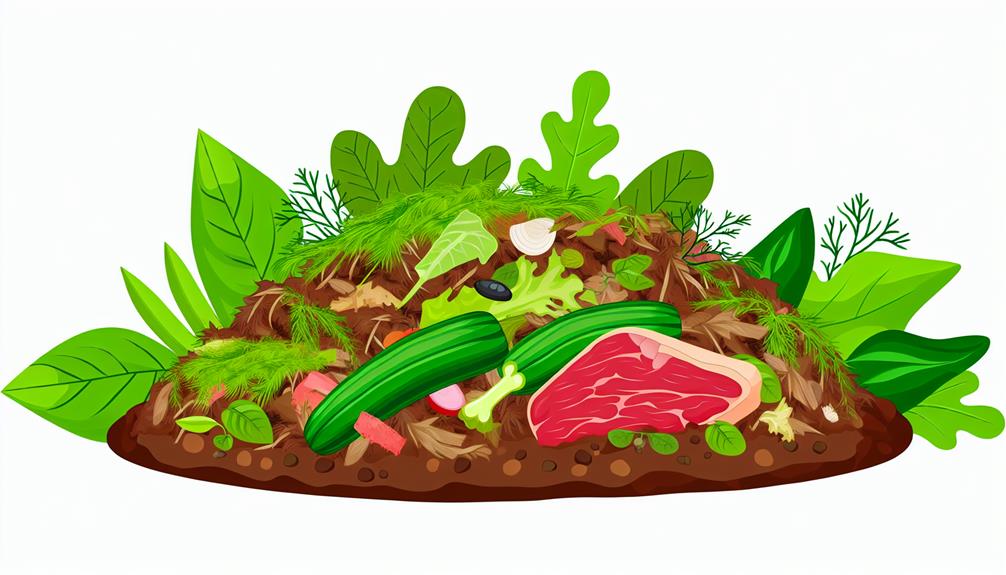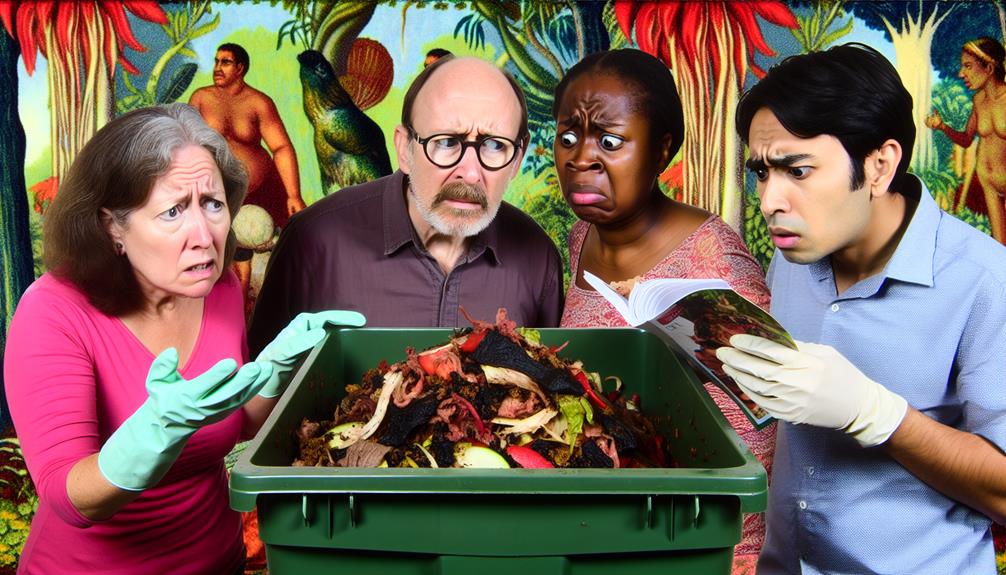

Yes, you can compost beef to enrich your soil with valuable nutrients! Microorganisms break down the beef, transforming it into nutrition-packed compost that boosts plant health. However, you’ve got to manage it properly to avoid attracting pests and spreading pathogens like E. coli.
High temperatures and regular turning help guarantee safe decomposition. Use a tight-fitting bin and balance green and brown materials for the best results. Beef introduces essential nutrients like nitrogen, making your garden thrive. Just be cautious and maintain proper conditions to prevent issues. Now, let’s explore how to master this eco-friendly practice!
To understand beef decomposition, you first need to grasp how organic materials break down in a composting environment. Organic matter, like beef, decomposes through a process involving microorganisms such as bacteria and fungi. These microorganisms thrive in specific conditions, needing moisture, oxygen, and the right temperature to break down the material effectively.
When you add beef to your compost, it starts breaking down into simpler compounds, providing nutrients that enrich the soil. This transformation happens as microorganisms consume the beef, producing heat and breaking it down into smaller components.
Ensuring a balance of green (nitrogen-rich) and brown (carbon-rich) materials in your compost pile helps maintain the ideal environment for decomposition, making the process smoother and more efficient.
Also Read: Can You Compost Passion Fruit?
Composting beef not only reduces food waste but also enriches your compost with valuable nutrients. By adding beef scraps to your compost pile, you’re introducing rich proteins and fats that break down into essential nutrients. These nutrients, like nitrogen and phosphorus, can greatly boost the health of your soil, fostering a more vibrant garden.
You’ll notice your plants growing stronger and more resilient, reflecting the high-quality compost you’ve created. Plus, engaging in composting helps you feel connected to a larger community of eco-conscious individuals. You’re not just improving your garden; you’re contributing to a more sustainable world.
Embrace the process, and you’ll find joy in transforming waste into something truly beneficial.
When you start composting beef, you’ll need to think about some common concerns and risks. Pathogen spread is a big worry since harmful bacteria can thrive in meat, and nobody wants that in their garden.

Additionally, composting beef might attract pests like rodents or flies, so it’s essential to manage your compost pile properly.
Handling beef during composting raises significant concerns about the spread of pathogens like E. coli and Salmonella. These bacteria can thrive in meat, posing risks to your health and the safety of your compost.
When you add beef to your compost pile, you risk contaminating the entire batch, making it unsafe to use in your garden. Properly managing your compost to avoid these pathogens requires maintaining high temperatures, which can be challenging. You’d need to monitor the pile closely, ensuring it reaches at least 140°F to kill harmful bacteria.
Adding beef to your compost pile can attract unwanted pests like rodents, raccoons, and flies. These pests can create messes, spread diseases, and disrupt your composting process.
To help you visualize:
You want your compost to be a healthy, thriving environment, free from intruders. By avoiding beef, you help keep these pests at bay, ensuring your compost remains clean and effective.
It’s essential for a community that values green practices and harmony with nature to understand these risks and make informed choices.
Also Read: Can You Compost Cardboard?
Controlling odors in your compost pile requires balancing the right mix of materials and ensuring proper aeration. To achieve this, combine green materials, like kitchen scraps, with brown materials, such as dry leaves or straw. This balance helps microbes break down your compost efficiently, reducing unpleasant smells.
Turn your pile regularly to introduce oxygen, which prevents anaerobic conditions that cause foul odors. Moisture levels are important too; your compost should feel like a damp sponge. If it’s too wet, add more brown materials to absorb excess moisture.
While managing odors is important, keeping pests and rodents out of your compost pile is equally critical. You don’t want your compost to become a buffet for uninvited guests.
Here are some effective tips to help you maintain a rodent-free compost:
Also Read: Can You Compost Carrot Peel?
Establishing the ideal composting conditions guarantees that your pile decomposes efficiently and produces nutrient-rich compost. Start by balancing green and brown materials; greens include kitchen scraps and grass clippings, while browns consist of leaves and cardboard. Aim for a ratio of roughly 2:1 browns to greens.
Maintain moisture levels akin to a wrung-out sponge, ensuring it’s neither too dry nor too wet. Turn the pile regularly to introduce oxygen, which helps microorganisms break down materials faster. Keep the temperature between 135°F and 160°F for best microbial activity.
To compost beef effectively, you need to follow specific methods to make sure it breaks down properly and safely. Beef can be tricky, but with the right approach, you can turn it into nutrient-rich compost.
Start by cutting the beef into smaller pieces; this speeds up decomposition.
Next, bury the beef deep in the compost pile to avoid attracting pests.
Maintain the proper moisture level, keeping it damp but not wet.
Use a compost thermometer to monitor temperature, aiming for 130-150°F.
Achieving the right balance of compost ingredients is essential for efficient decomposition and nutrient-rich compost. You need a mix of ‘greens‘ and ‘browns‘ to keep your compost pile thriving. Greens, like beef scraps, vegetable peels, and coffee grounds, provide nitrogen, fueling the decomposition process.
Browns, such as dry leaves, cardboard, and straw, add carbon, keeping the pile aerated and preventing odors. To get it right, aim for a ratio of about 2 parts browns to 1 part greens. This balance helps maintain the microbial activity vital for breaking down materials.
Layer your compost with alternating greens and browns, ensuring even distribution. By doing this, you create an inviting environment for helpful bacteria and fungi, leading to rich, fertile compost.
Also Read: Can You Compost Yard Trimming?
Once you’ve balanced your compost ingredients, it’s crucial to regularly monitor the decomposition process to make sure everything is breaking down effectively. This guarantees that your compost remains healthy and productive.

Keep an eye out for the following:
Also Read: Can You Compost Ice Cream?
When your compost is ready, you can use it to enhance soil quality and boost the nutritional value of the beef cattle’s grazing pastures. Spread the compost evenly over the fields to enrich the soil with essential nutrients. This not only improves the pasture’s quality but also contributes to healthier, more robust cattle, creating a sense of pride and accomplishment within your community.
Your efforts create a sustainable cycle, where your herd benefits from the nutrient-rich soil, and in turn, produces quality beef. By using compost, you’re fostering an environment where both the land and cattle thrive together. This shared success strengthens the bond between you and your peers, reinforcing a collective commitment to sustainable farming.
By composting beef, you’re not only reducing waste but also enriching your compost with valuable nutrients. Sure, it requires a bit more attention to manage odors and deter pests, but the benefits are worth it.
With proper techniques and a balanced mix of ingredients, your compost will thrive. So, don’t shy away from composting beef—embrace it for a more sustainable and nutrient-rich garden.
Start today and see the difference it makes!
